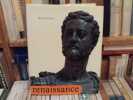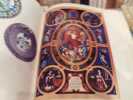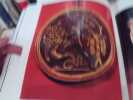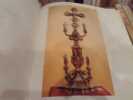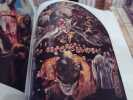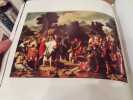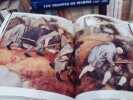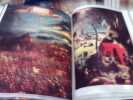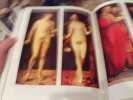[ART] - JESTAZ (Bertrand)
L'Art de la Renaissance.
Paris, Éditions d'Art Lucien Mazenod, 1984 ; in-4 (255 x 320 mm), 608 pp., reliure d'éditeur pleine toile, coloris blanc, sous jaquette illustrée et emboîtage. Collection«l'Art & les Grandes Civilisations», N° 14. Nombreuses illustrations en noir et blanc et en couleurs.
Reference : 202304657
Bookseller's contact details
Librairie Alphabets
M. Philippe Henry
06 87 32 55 92
Payment mode

Sale conditions
Conforme à la vente par correspondance.
5 book(s) with the same title
Art of the Renaissance Book. Tributes in Honor of Lilian Armstrong
, Brepols, 2023 Hardback, 480 pages, Size:220 x 280 mm, Illustrations:15 b/w, 142 col., Language(s):English, Italian, French. ISBN 9782503584638.
Summary This book presents new research by eminent and emerging scholars in honor of Lilian Armstrong, whose extraordinary research has elucidated a vast corpus of imagery previously hidden inside manuscripts and books produced in late medieval and Renaissance Venice and the Veneto. Armstrong was one of the pioneers focusing upon the unique nature of each copy of early printed editions, an approach which has transformed the field of book history. Her studies of antiquarian imagery in books and manuscripts revealed the inventiveness and originality of these works, and that many important classical motifs initially emerged in such marginal spaces before they were canonized in sculpture and oil painting. The contributions by art historians, manuscript scholars, and book historians collected here on the book arts across Europe are testimonies to the fact that Lilian Armstrong's research has been highly influential across disciplines and geographical areas of study. TABLE OF CONTENTS INTRODUCTION The Art of the Renaissance Book: Honoring Lilian Armstrong Helena Katalin Sz pe and Ilaria Andreoli PART I: EARLY PRINTED BOOKS AND THEIR DECORATION I, libelle: Rodericus Zamorensis Launches his Book Martin Davies The Graphic Style of the First Books Printed in Venice Renzo Baldasso Italian Book Design as Paradigm and Challenge for German Artists, Intellectuals, and Printers (among others Ulrich Schreier, Hartmann Schedel, and G nther Zainer) Christine Beier Nicolas Jenson and Jacobus Rubeus in Cologne and Zutphen Lotte Hellinga Une nigmatique illustration dans un incunable v nitien Fran ois Avril Il Calepino 1533: una doppia emissione, un frontespizio "metalibrario," e una nuova edizione delle Tre Parche Edoardo Barbieri PART II: MANUSCRIPT PAINTING IN ITALY An Illustrated "Esopo" of the Veneto in the British Library Matilde Malaspina Una nuova tessera per l'attivit di Cristoforo Majorana e la biblioteca di Andrea Matteo III Acquaviva Teresa d'Urso Per Alessandro Leoni, Antonio Maria da Villafora, e il Maestro delle Sette Virt Giordana Mariani Canova Due codici miniati da Antonio Maria da Villafora: un commentario al primo libro delle Sentenze di Egidio Romano della Biblioteca Angelica e un messale del Mus e Jacquemart-Andr Federica Toniolo and Gennaro Toscano Benedetto Bordon, the Barozzi Breviary Master, and the Venetian Procurators of Saint Mark Helena Katalin Sz pe Il miniatore Giorgio Colonna e la raffigurazione dell'Arsenale veneziano Susy Marcon PART III: COLLECTING AND THE HISTORY OF SCHOLARSHIP ON EARLY BOOKS Venetian Miniatures in Munich Incunabula: New Additions Ulrike Bauer-Eberhardt An Ex-Celotti Antiphonal Cutting Inscribed "BF" in the North Carolina Museum of Art Lyle Humphrey Re-uniting Cuttings by Antonio Maria da Villafora Collected by James Dennistoun in Padua in 1839 with their Parent Manuscript Jonathan J.G. Alexander Les Missels imprim s Venise (1896): storia di un incunabolo moderno Ilaria Andreoli
Masaccio and the Art of Early Renaissance Florence
Indiana University Press 1980 288 pages 16 69x23 19x2 82cm. 1980. Cartonné jaquette. 288 pages.
Bon état rousseurs sur tranche intérieur propre avec sa jaquette (en bon état)
Painting as a Modern Art in Early Renaissance Italy
, Brepols - Harvey Miller, 2020 Hardback, 366 pages, Size:220 x 280 mm, Illustrations:11 b/w, 115 col., 1 tables b/w., Language: English. ISBN 9781912554003.
Summary Concepts of modernity have played a constitutive role in the canon of European art history at least since Giorgio Vasari, who looked back upon Giotto as the founder of "modern art" (arte moderna). The aim of this book is to establish a prehistory of Vasari's view. Was Vasari merely projecting a sixteenth-century concept of artistic modernity onto the fourteenth and fifteenth centuries, or were the artists of that period guided by some notion of modernity as well? Brennan argues that discussions of "modern art" were in fact widespread during Giotto's time, according to the broad, medieval definition of "art" (ars) that encompassed activities as diverse as arithmetic, poetry, carpentry, music, and preaching. Within this discourse, to make an art "modern" meant setting it on a new foundation in "science" (scientia) and rationalizing it accordingly. By the year 1400, Florentine writers such as Cennino Cennini and Franco Sacchetti were applying these same terms and principles to Giotto. In doing so they shed light not only on the structure of artistic development in the fourteenth century, but also on the way Giotto's legacy shaped the prerogatives of artists in the early fifteenth - that is, in the generation of Brunelleschi, Donatello, and Masaccio.
L'art de la Renaissance et du Baroque.
Paris, Elsevier Sequoia, 1979; in-8, 523 pp., cartonnage de l'éditeur. Très bon état avec jaquette - dos insolé. Ex-libris de Paul Eschbach.
Très bon état avec jaquette - dos insolé. Ex-libris de Paul Eschbach.
L'art de la Renaissance en France L'invention du classicisme
Editions Flammarion, Paris, 1996. Fort in-4, reliure pleine toile éditeur sous jaquette illustrée en couleurs, 414 pp. Introduction - I. Le gothique à la Renaissance - II. Fontainebleau, Rosso et la Galerie François Ier - III. Le classicisme antiquisant des années 1540 : Cellini, Serlio et Primatice - IV. Les enseignements de Fontainebleau - V. Lescot, Goujon ...
Avec 459 illustrations en noir et en couleurs in et hors texte.Avec un envoi autographe signé de l'auteur sur le faux-titre. --- Plus d'informations sur le site archivesdunord.com
Phone number : 01 42 73 13 41
 Write to the booksellers
Write to the booksellers